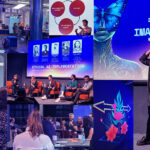AI in Journalism 2024: My Journey

When we published an AI-generated front page at Dagens Arbete in 2023, it led to an interesting internal discussion.
2024 has been a transformative year both for me as a journalist and for artificial intelligence, and in the long term for its application in journalism. It’s easy to feel overwhelmed by all the news in this area. In a series of blog posts I will try to summarize where we are at, starting off with my own journey into this field.
This year, I delved seriously into AI in journalism, after spending a couple of years experimenting in my spare time with various generative AI services — mainly ChatGPT and Midjourney.
AI-driven Journalism and Media Production
The starting point of my AI journey in journalism was a course in AI-driven Journalism and Media Production at Linnaeus University in early 2024. There, we explored various generative AI applications in journalism and tested different GenAI services.
The course culminated in an individual project. I chose to explore tools for a journalistic AI toolkit integrated into the WordPress CMS, inspired by Aftonbladet’s AI toolkit. The central question was: Which tools are most essential, and how could I effectively deploy them in WordPress?
The main reason for wanting the solutions to be integrated into the CMS is ease of use. For the AI sceptics or just generally new tech sceptics out there, ease of use – and explainability – is key. It will be important to promote adaptation of these tools for all journalists.
These were the ten AI applications I wished for
- Buddy reader / feedback tool – checks the text for unanswered questions, contradictions, unnecessary repetition, and overall balance. It also identifies the main message and verifies if it appears in the preamble.
- Swedish grammar and style – ensures the text follows “TT-språket”, the Swedish language guide.
- Headline suggestions – generates potential headlines based on the content.
- Social media texts (and images) – adapts article summaries for platforms like X, Facebook, LinkedIn, etc.
- Subheading suggestions (mellanrubriker) – inserts subheadings to improve readability.
- SEO-friendly headlines and texts – suggests keywords and headings optimized for search engines.
- Three-bullet-point summaries – condenses the article into three key points.
- Tag generation – proposes relevant tags to categorize the article.
- Fact boxes with source links – extracts key areas to delve deeper into in a facts box, finds the facts and presents them along with source references.
- Consistent illustrations – uses AI-generated images in a uniform style, for instance for Q&A sections like DA’s “Fråga om jobbet” (a work-related Q&A section where experts answer readers’ questions).
Out of these ten applications, seven were possible to implement in WordPress at that time, with results ranging from ‘okay’ to ‘good’. However, the remaining three posed challenges that neither I nor the available plugins could solve back in March 2024. (An eternity ago in AI terms!)
The ones where my efforts, and the WordPress plugins available at the time, failed, were:
- Creating subheaders within the text in wordpress. It was of course possible to do this outside of WordPress, but that wasn’t what this test was about. Again: Ease of use is key. Copy/paste just isn’t worth it for a few subheaders.
- Facts boxes with links to sources. At the time, this did not yield good results. It would probably be a bit better now in December of 2024. But this is a good example of when AI can be used as a tool in the research process, but probably shouldn’t be left to do the job alone. We need a human not only in the loop, but in control.
- Illustrations for the section Fråga om jobbet, work-related questions from readers to experts. Building this into WordPress failed. But I got quite good results outside of WordPress, with Midjourney and their “style reference” feature.
I presented the results in a report and gave a presentation in Kalmar to my coursemates.
IT-högskolan: Developer in AI and Machine Learning
Around the same time, I faced a difficult decision regarding my role at Dagens Arbete, where I served as Head of Digital. When weighing my opportunities there against a future more focused on AI development, I found myself wanting to move on. But where to? I knew I wanted more hands-on practical knowledge of AI development.
I ended up applying to three different vocational programs to become a developer with a focus on AI and Machine Learning. Luckily I got in to my top choice, IT-högskolan Stockholm (ITHS).
The first semester has been amazing. It started out with a hackathon, setting a tone of playful and exploratory learning. The task was to create a game in Microsoft MakeCode Arcade. It was a fun exercise in collaboration, learning a new coding platform and finding creative solutions.
Our game, Duck Debugger, where the ITHS rubber duck helps they player shoot down bugs and gather coding insights in the form of lightbulbs, finished second.
The first week we also had a short introduction to AI and ethical challenges. Since then, our focus has been on building the foundations for AI development. Python programming, Data processing, Linear algebra. The upcoming course in January is Statistics. After that we can get into Machine Learning, so that will be exciting.
I was elected the student representative for the board for the AI developer program. It’s been interesting to take part in the discussions and hear the reasoning behind how the program is set up. And to work for change when needed.
I have also been a part of SheTech, an initiative from ITHS’s Tech Lead, Toni Löf, who has created a monthly meeting for female and non-binary students. Usually there’s a guest speaker, and the focus is on empowering eachother, discussing both tech issues and the perspective of being a woman/non-binary in the tech industry. At the last meeting of the semester, Toni herself gave us useful advice for Git and GitHub.
University courses: Natural Language Processing and Prompt Engineering
As I had some previous experience in both Python and data processing, I could add a couple of university courses on top of my ITHS studies. They both lined up well with the ITHS program, one giving me a preview of what’s to come, the other one serving as a complement.
1. ”AI för naturligt språk”
Institutionen för datavetenskap, Linköpings universitet, 3 hp.
This course in Natural Language Processing (NLP) was super interesting, intense, sometimes challenging, and gave a really good introduction and sometimes deep dive into this area, which means I will be prepared when we are to study this in my ITHS program. Labs were conducted in a Python environment on the course web pages, making it easily accessible from any computer, which was a plus.
Some of the topics discussed: What is NLP? Annotation, statistical properties of language data, segmenting text, tokenization, corpuses, lexemes and lemmas, Zipf’s and Heap’s law. Text classification, Naive Bayes, sentiment analysis, balancing data, logistic regression, word embeddings, neural networks, word2vec, contextualization. Sequence tagging, accuracy, precision, recall, local and global search, dependency parsing, evaluation (UAS and LAS), transition based dependencies, N-gram models, unigram, bigram, maximum likelihood estimation, recurrent neural networks, neural machine translation.
2. ”Prompt Engineering och problemformulering för AI”
Högskolan Kristianstad, 3 hp.
This course was about learning to give good instructions – prompts – for AI models. It gave an overview of generative AI models, the principles of constructing good prompts, methods for text generation and how to evaluate AI-generated texts. It also touched upon things like zero, one and few shot prompting, chain of thought reasoning, data analysis with Claude and ChatGPT, custom GPTs, the AI Act, local models and automation.
Preparing for an AI Agent hackathon
This is quite exciting. Three of my coursemates at ITHS – Rafael Schmidl, Sunny Vanderwall and Christian Armgarth – and I started talking about AI Agents and how we wanted to learn more. Agentic AI will be a large part of AI in 2025. But building these agents are not a part of our courses at ITHS. We decided to do something about that.
In February we are hosting a hackathon where fellow students at ITHS will explore building agents using the CrewAI framework (a platform for building agentic AI solutions). Right now we are exploring the tools ourselves and building our own understanding of them. I can’t wait to see what the participants make of it!
Going to AI events
From the get-go, our main teacher at ITHS, Ali Leylani, emphasized the importance of building a network with other people in the AI sphere. This is only one of the reasons for attending meetups and seminars on AI. Another is to get some understanding of the field, how it spans over many different areas and technologies. I have thoroughly enjoyed going to local Stockholm events, online seminars and also taking the leap and applying for – and getting accepted – a sponsored ticket to Data Natives in Berlin. You can read about my main takeaways from the latter in this blog post.
These are the in-person events I attended in Stockholm:
Sept. 19: Stockholm AI Summit – AI in Professional Services, by Stockholm AI.
Key takeaway: Plenty of new buzzwords to explore! It’s funny to think I hadn’t even heard of RAG at that time.
Oct. 3: MLOps & AI Governance, by the MLOps Community Stockholm, at AI Sweden.
Key takeaway: The field is maturing. Interesting demos of frameworks for AI governance and compliance with regulations.
Oct. 16: Knowledge Graphs in the era of Gen AI, by Stockholm AI, at EQT.
Key takeaway: What are knowledge graphs, and why aren’t they used more?
Nov. 5: Green AI: Smashing your models with Pruna AI, by Stockholm AI, at EQT.
Key takeaway: Energy-efficient AI techniques.
Nov. 7: MLOps & AI Governance Take #2, by the MLOps Community Stockholm, at Generator.
Key takeaway: I learned how differently AI risks are viewed in the EU versus the US. According to Luis Martinez, Global AI Product Compliance Manager at Assa Abloy, the EU classifies risks by their impact on human rights, while the US focuses on risks that might impact AI systems in different scenarios. China reportedly uses a mix of both approaches.
Nov. 13: Gen AI State of Play – Presented by a Global AI Executive, by Australian Business Council of Sweden, at Magnusson Law.
Key takeaway: An eye-opening discussion among lawyers about the AI Act and its implications for businesses.
Dec. 5: Women in AI Christmas Meetup with Annie Lindmark, at B3 Consulting.
Key takeaway: There are lots of smart women who are into AI! Great talk by Annie Lindmark.
Dec. 18: Stockholm AI, ML and Computer Vision Meetup, by Voxel51, at Fotografiska.
Key takeaway: Fascinating demos of self-driving car systems and an in-depth look at Voxel51’s FiftyOne tool for refining training datasets.
For keeping up with AI in journalism though, online events have been the key. Especially the two-day Journalism AI Festival gave valuable insights, some of which I’ll get back to in later posts in this series.
Other notable online events this fall:
- IMPACT 2024 – The Data Observability Summit.
- JournalismAI Connect | Academic Calls – Rana Arafat
- Women in AI Summit 2024
Keeping track of events about AI can be hard, but a good starting point is following relevant organizations on LinkedIn and on Eventbrite and Meetup.
I am looking forward to even more learning, exchanges and insights in the upcoming semester. I managed to get hold of a ticket to NAMS in Copenhagen, so that will be great.
If you have any questions or suggestions for topics to explore or events to check out, feel free to leave a comment below or reach out on LinkedIn!







Recent Comments